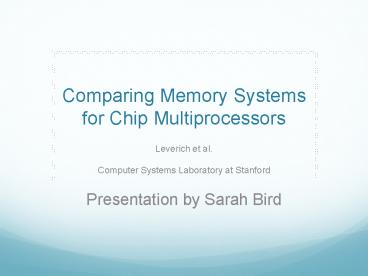Comparing Memory Systems for Chip Multiprocessors PowerPoint PPT Presentation
1 / 18
Title: Comparing Memory Systems for Chip Multiprocessors
1
Comparing Memory Systems for Chip Multiprocessors
- Leverich et al.
- Computer Systems Laboratory at Stanford
Presentation by Sarah Bird
2
Parallel is Hard
- Memory system has a big impact on
- Performance
- Energy consumption
- Scalability
- Tradeoffs between different systems are not
always obvious - Performance of a the memory system is very
dependent on - the workload
- the programming model
3
Memory Models
- Cache-Based Memory
- Streaming Memory
- Hardware-managed
- Implicitly-addressed
- Reactive
- Advantages
- Best effort locality and communication
- Dynamic
- Easier for the programmer
- Software-managed
- Explicitly-addressed
- Proactive
- Advantages
- Software can efficiently control addressing,
granularity and replacement - Better latency hiding
- Lower off-chip bandwidth
4
Questions
- How do the two models compare in terms of overall
performance and energy consumption? - How does the comparison change as we scale the
number or compute throughput of the processor
cores? - How sensitive is each model to bandwidth or
latency variations?
5
Baseline Architecture
- Tensilica Xtensa LX
- 3-way VLIW core
- 2 slots for FP
- 1 slot for loads stores
- 16-Kbyte I-Cache
- 2-way set associative
- In-order processors similar to
- Piranha
- RAW
- Ultrasparc T1
- XBox360
- 512-Kbyte L2 Cache
- 16-way set associative
6
Cache Implementation
- 32-Kbyte
- 2-way set associative
- Write-back, write allocate policy
- MESI write-invalidate protocol
- Store Buffer
- Snooping requests from other cores occupy the
data cache for one cycle - Core stalls if trying to do a load or store in
that cycle - Hardware stream-based Prefetch engine
- History of last 8 cache misses
- Configurable number of lines runahead
- 4 separate stream accesses
7
Streaming Implementation
- 24-Kbyte local store
- 8-Kbyte cache
- Doesnt account for the 2-Kbytes of tag
- DMA Engine
- Sequential
- Strided
- Indexed
- Command queuing
- 16 32-byte outstanding accesses
8
Simulation Methodology
- CMP Simulator
- Stall events Contention events
- Core pipeline Memory System
- 11 applications
- Fast-forward through initialization
9
Performance Comparison
10
Off-Chip Traffic
- Streaming has less memory traffic in most cases
because it avoids superfluous refills for output
only data - Bitonic Sort writes back unmodified data in the
streaming case
11
Energy Consumption
- Energy Model
- 90 nm CMOS process
- 1.0 V power supply
- Usage statistics
- Energy data from layout of 600MHz design
- Memory Model use CACTI 4.1
- Interconnect uses a model and usages statistics
- DRAM uses DRAMsim
12
Increased Computation
- 16 Cores
13
Increased Off-Chip Bandwidth
- 3.2 GHz
- 16 Cores
- Doesnt close the energy gap
- Needs non-allocating writes
14
Hardware Prefetching
- Prefetch Depth of 4
- 2 Cores
- 3.2 Ghz
- 12.8 GB/s memory channel bandwidth
15
Prepare for Store
16
Stream Programming
17
Results
- Data-Parallel Applications with high data reuse
- Cache and local store perform/scale equality
- Streaming is 10-25 more energy efficient than
write-allocate caching - Applications without much data reuse
- Double-buffering gives streaming a performance
advantage as the number/speed of the cores scales
up - Prefetching helps caching for latency bound apps
- Caching out performs streaming in some cases by
eliminating redundant copies
18
Conclusions
- Streaming Memory System has little advantage over
cache system with prefetching and non-allocating
writes - Streaming Programming Model performs well even
with caching since it forces the programmer to
think about their applications working set

